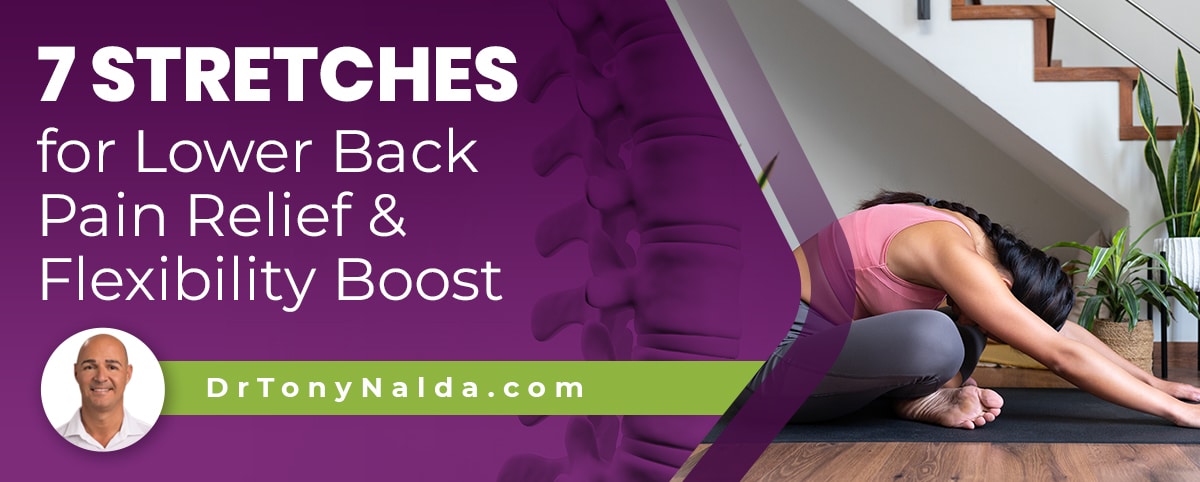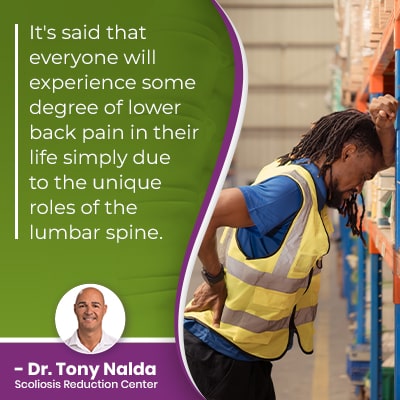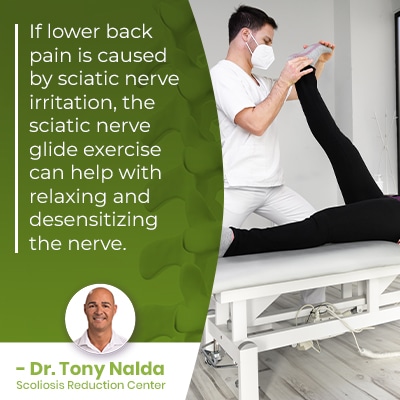7 Stretches for Lower Back Pain Relief & Flexibility Boost

A person can experience back pain for a number of reasons: spinal degeneration, poor lifestyle choices, weak muscles, spinal rigidity, and the presence of an underlying spinal condition. When it comes to lower back pain, stretching exercises can help relieve pain by keeping the spine strong and flexible, along with strengthening and stretching the spine's surrounding muscles so they can optimally support and stabilize the spine.
As the design of the spine is based on movement, staying active is important for spinal health. Lower back pain is something most people will experience at some point in their lives, and certain stretches can help maintain spinal flexibility, surrounding muscle strength, and relieve lower back pain.
Before getting to 7 specific stretches to use for lower back pain, let's first explore some basic spinal anatomy for a better understanding of the importance of leading a spine-friendly lifestyle that includes regular stretching.
Table of Contents
Anatomy of a Healthy Spine
As mentioned, the very design of the spine is based on movement, and it's designed to avoid degeneration for as long as possible, but that also requires leading a spine-friendly lifestyle.
The spine's healthy curves keep it strong, flexible, and better able to absorb and distribute mechanical stress during movement, and when those curves are in place, the spine's vertebrae are aligned as they should be: stacked on top of one another in a straight and neutral alignment.
Sitting between each pair of adjacent vertebrae is an intervertebral disc, and the health of these spinal structures are often the cause of many spinal conditions/issues as they are commonly the first spinal structures to deteriorate; movement helps keep the discs hydrated and healthy.
The spine has three main spinal sections that are vulnerable to back pain in different ways and for different reasons: the cervical spine (neck), the thoracic spine (middle/upper back), and the lumbar spine (lower back).
Lower Back Pain
 It's said that everyone will experience some degree of lower back pain in their life simply due to the unique roles of the lumbar spine.
It's said that everyone will experience some degree of lower back pain in their life simply due to the unique roles of the lumbar spine.
The lumbar spine contains five vertebral bodies of the spine (L1 to L5), and they are the largest vertebrae because they have some key roles to play in maintaining spinal health and function.
Those five vertebrae, and the discs in between, have to support the weight of the spinal sections above, the entire trunk, and they also feel the effects of bending, twisting, and lifting motions.
In general, when a section of the spine is adversely affected, the area located closest to the affected spinal section is going to feel the bulk of its direct effects, so when we're talking about issues with the lumbar spine, that includes lower back pain and lower body complaints.
For example, a common cause of lower back pain/lower body issues involves sciatic nerve compression; the sciatic nerve starts in the lumbar spine and extends throughout the lower body, and if it's irritated, it can cause pain felt anywhere along its extensive pathway.
To prevent and relieve lower back pain, stretching exercises can help to keep the spine loose, flexible, and strong, and they can also help relieve pressure on the spine, its individual structures, and surrounding muscles and nerves, and they can also help keep the spine's surrounding muscles loose and flexible so they can help support the spine.
While not all spinal conditions are preventable, leading a spine-friendly lifestyle that includes a healthy activity level and regular stretching can help slow the level and rate of age-related spinal degeneration, helping to preserve optimal spinal function for as long as possible.
Consider using one or more of the following 7 stretches for lower back pain:
1) The Piriformis Stretch
The piriformis muscle is located deep in the buttocks and is involved in pelvis and hip rotation and leg function during movement, and stretching this muscle can help address pain and/or tight muscles in the lower back and buttocks.
To stretch the piriformis muscle:
- Lie down on the floor with both knees bent and feet flat on the floor
- Place the right ankle on the left leg, just above the knee
- Place the hands behind the left thigh and pull upwards towards the chest until a deep stretch is felt
- Try and maintain the pose for up to a minute
- Repeat the stretch with the other leg
2) The Child's Pose
The child's pose is a popular yoga pose used to gently stretch the gluteus maximus, spinal-extensor muscles, and the thigh muscles.
When performed properly, this stretch can help relieve pain and reduce adverse spinal tension in the upper spine, which also helps the lumbar spine relax and loosens tight muscles that surround the lumbar spine.
Loosening muscles and relieving tension helps take pressure off the spine's individual structures, and it also helps improve circulation around the spine: important for the health of its intervertebral discs.
Steps for performing the child's pose stretch include:
- Placing the hands and knees on the ground while rocking backwards through the hips until sitting on the heels of the feet
- Hinging forward at the hips, and while rocking forwards, walk the hands out in front in full extension
- Making contact between the stomach and thighs
- Extending the arms out in front of the body and/or alongside the body with the palms flat and facing upwards
- Being mindful of breathing, relaxing, and focusing on tense and tight areas of the body
- Holding the pose for up to a minute and repeating as stiffness returns throughout the day
- Knee to Chest Stretch
The knee to chest stretch can help relax the glutes, hips, and thigh, and is a type of hip flexor stretch.
Hip flexors are key to hip flexibility, maintaining a longer stride, and can help reduce lower back pain, hip, groin, and/or knee pain.
To perform the knee to chest stretch:
- Lie flat on the floor with both knees bent and forming a straight line
- Pull the right knee upwards into the chest while using the hands to grasp the back of the thigh or front of the shinbone
- Maintain the left leg's position of being extended and straight on the floor
- Be mindful of breathing and releasing stress and tension
- Maintain the pose for up to a minute
- Repeat with the other leg
4) Sciatic Nerve Glide Exercise
 If lower back pain is caused by sciatic nerve irritation, the sciatic nerve glide exercise can help by relaxing and desensitizing the nerve.
If lower back pain is caused by sciatic nerve irritation, the sciatic nerve glide exercise can help by relaxing and desensitizing the nerve.
The sciatic nerve is the largest in the body, and when it's relaxed and desensitized, it's less likely to become inflamed, irritated, and cause lower back pain.
To perform a sciatic nerve glide exercise:
- Sit up straight in a chair while straightening one knee and keeping the other foot flat on the floor
- Slowly bend the ankle in towards the body until the toes are pointing back and up
- Continue bending the ankle back and forth while bending the toes back and away from the body, and then back in towards the body
- Pump the ankle in this manner for approximately 15 to 20 minutes
- Alternate with the other leg
5) Back Flexion Stretch
Back flexion stretches involve the spine being stretched in a forward bend position that helps increase spinal flexibility, relieve stiff/tight spinal and abdominal muscles, and increase abdominal strength.
Performing back flexion stretches regularly can help prevent spinal rigidity, muscle strain and stiffness, and related nerve issues like sciatica.
Performing back flexion stretches involve:
- Lying on the floor with the back flat
- Gently pulling the knees upwards into the chest until a deep stretch is felt in the lower and middle back
- Gently and slowly raise the head for an added stretch
- Hold the pose for approximately 10 seconds
6) Supine Twist
Performing a supine twist is highly effective at stretching the lower back and glutes, which are known to become excessively tight when lower back pain is an issue, adding to pain levels.
To perform a supine twist and increase spinal flexibility:
- Start by lying on flat on the back with the knees bent and feet flat on the floor
- Extend the arms out to the side to form a 'T' shape
- Maintain shoulder contact with the floor while gently rolling both knees to the side
- If the stretch is painful, placing a pillow or rolled towel under the knees can help ease the twisting motion
7) Pelvic Tilt
Oftentimes, with lower back pain comes the sensation that the entire pelvis is stiff and immovable.
The pelvic tilt can help increase pelvic mobility by gently relieving pressure on the sciatic nerve and increasing strength of the abdominal muscles.
Performing a pelvic tilt involves:
- Lying on the floor with the knees bent and feet flat on the floor
- Being mindful about keeping the lower back relaxed and in a neutral position
- Engage the core muscles while flattening the lower back against the floor: achieved by gently tilting the pelvis
- Repeat this movement up to 15 times
Conclusion
While there is a certain amount of spinal degeneration to be expected with age, the spine was designed not to degenerate, and lifestyle factors play an important role in a person's level and rate of natural age-related spinal degeneration.
Leading a spine-friendly lifestyle can help maintain a positive quality of life as the spine is a key structure that doesn't just allow us to stand upright and practice good posture, it protects internal organs, enables flexible movement, and works in tandem with the brain to form the body's central nervous system (CNS).
Lifestyle choices that impact spinal health and lead to lower back pain include carrying excess weight, chronic poor posture, excessive consumption of alcohol and/or smoking, repeatedly lifting heavy objects incorrectly, and lack of exercise.
The spine requires regular movement to stay healthy, and its intervertebral discs require movement to improve circulation around the spine so important nutrients and oxygen needed for rejuvenation are accessible via the discs' surroundings.
Performing regular gentle stretching of the spine and its surroundings can help keep the spine flexible, its surrounding muscles strong, and back pain at a minimum.
Due to the unique roles of the lumbar spine, its vertebrae and surroundings are particularly vulnerable to the development of a number of issues, and stretches such as the child's pose, supine twist, pelvic tilt, the sciatic nerve glide exercise, etc., can help proactively prevent and relieve lower back pain.
Dr. Tony Nalda
DOCTOR OF CHIROPRACTIC
After receiving an undergraduate degree in psychology and his Doctorate of Chiropractic from Life University, Dr. Nalda settled in Celebration, Florida and proceeded to build one of Central Florida’s most successful chiropractic clinics.
His experience with patients suffering from scoliosis, and the confusion and frustration they faced, led him to seek a specialty in scoliosis care. In 2006 he completed his Intensive Care Certification from CLEAR Institute, a leading scoliosis educational and certification center.
About Dr. Tony Nalda
 Ready to explore scoliosis treatment? Contact Us Now
Ready to explore scoliosis treatment? Contact Us Now





